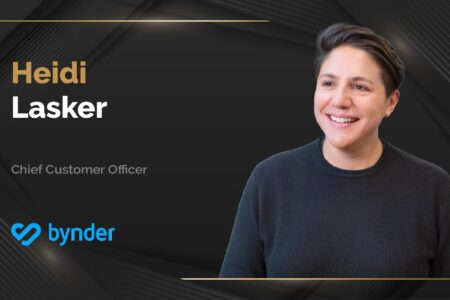“It’s important to build a culture where there’s empathy, strong communication and collaboration. Be open to feedback that you’re getting and give honest feedback. If you do that, everyone should be empowered to drive the success of your customers and know how their role makes an impact.”
Please tell us more about your professional background and your role at Bynder?
I’ve been working in technology companies in customer-facing roles for just over 25 years. I started before there was such a thing called “customer success”. It was called “account management” or “relationship management” previously.
Before I got to Bynder, I spent most of my career in start-ups, joining smaller businesses as the first customer-facing person to put processes in place and lay the foundation for a growing team. I joined Bynder in late 2017, coming in as the Head of US Customer Success.
When I joined, I had four customer success managers on my team initially, but over time with acquisitions, organic growth, the creation of the customer experience group and different post sales customer facing teams becoming part of Customer Success, the team continued to grow. Now with my promotion to the CCO role, the team has become global. Over six years going from managing four people to 150 or so has been a fun ride.
Talk to us about the importance of content
Content is mission-critical and the reason it’s so important is that consumer expectations have continued to rise. Think about when you’re served content – it catches your attention if it’s relevant to you and if it’s not, it’s just noise.
In order for brands to compete in the market, they have to have targeted, relevant, visually compelling content so they can get and keep the attention of their customers.
On top of that, content is growing exponentially because of all the channels and variations you need to meet the demands of consumers – and then of course, you need to get to market quickly.. The ability to create and deliver this personalized, compelling content quickly and at scale is key to delivering exceptional content experiences.
What is DAM and why is it important to marketers?
Digital Asset Management, or DAM, is a software that’s used to store, organize and manage digital assets. Managing this content in a way that makes it easy to find and use is important for things like streamlining collaboration, driving brand consistency, control and compliance and getting your content to market faster. DAM also drives asset reuse so you can maximize the value of your content at a time when you need to do more with the same or less resources.
The importance of content has really driven DAM to be critical for a few reasons. Content is growing exponentially because of things like the need for targeted, relevant content or generative AI and you need to be able to effectively manage it. You also need to have a single source of truth so you can automate the distribution of content across channels – and when you do, you ensure you’re delivering the right content to the right place at the right time. Delivering this exceptional content experience will set brands apart from their competitors.
Also Read: MarTech360 Interview With Nick Markman, Director of Product Management At Evocalize
How does Bynder differentiate itself from other brands in the space?
First, it’s the product – we have the leading enterprise DAM in the market. Second, the services that we provide to unlock the full value of our platform are just as important. Our team’s knowledge and expertise builds trust with customers and that really sets us apart.
Bynder is known for ease of use and a great user experience. The platform is also highly configurable and flexible so you can align the DAM to your GTM strategy, your user groups with your organizational structure and your language and terminology with your taxonomy.
And it’s not only teams that we connect. We have one of the most integrated DAMs in the market, with connections to over 220 adjacent technologies. This means you can create a piece of content, store it in the DAM and distribute to all of your customer facing channels seamlessly.
On the service side, we’ve been doing this for 10+ years. We’ve implemented thousands of customers, many with multi-brand, multi-region, multi-product, very complex go-to-market strategies. So the services that we provide are vital to ensure the DAM implementation enables our customers to get the most value and achieve their strategic priorities.
How do AI capabilities in Digital Asset Management systems contribute to overcoming challenges faced by marketers in managing content at scale?
More content will be created faster than ever before because of AI, so it’s more important than ever to have a place to manage it. Approvals and identification of AI generated content will become even more important, so that you have checks and balances over machine-created content, which is the approach we take in our Content Workflow product.
We see AI as an extension of Bynder’s core value proposition – both building on the scale and efficiency we’ve always had in our product as well as the ease of use, adoption and user experience Bynder is known for. Our customers have full control over the decision to use AI and they can use our functionality on their own terms with auditing, human oversight and permissions.
How does Bynder prioritize and elevate the overall customer experience, and what specific initiatives or strategies has the company undertaken to consistently enhance customer satisfaction and foster loyalty?
It starts with the fact that we have 150 people on our global customer-facing team. I think that shows our commitment to the customer experience. I don’t think there’s any other pure play DAM company in the market that has a customer team that size.
In addition, we view our services to be equally important as the technology in order to unlock the value of the investment so that drives our approach to the customer experience. We’re also strongly focused on enhancing the customer experience with things like our Community, peer-to-peer networking programs, customer education, webinars and workshops and customer events.
We’ve paid attention to the needs of our customers and have evolved our service offering to meet their needs; where they are, what’s important to them and how they want to work – with a strong focus on driving value and outcomes.
What advice would you give to brands looking to build a customer-centric org?
Cross-functional collaboration and breaking down silos is foundational to all of it. If you operate in silos, it will be really challenging to build a customer-centric culture.
It’s important to build a culture where there’s empathy, strong communication and collaboration. Be open to feedback that you’re getting and give honest feedback. If you do that, everyone should be empowered to drive the success of your customers and know how their role makes an impact.
Context is crucial. We’re enabling our customers to create, manage and distribute their content so they can drive exceptional content experiences.. Many of our customers have large budgets for content creation and are investing heavily in their marketing ecosystem to get this content into the market so it’s important for us to support them and make sure they get it right. That kind of context is crucial to the teams who are delivering on our brand promise, and we share these types of insights with our go-to-market teams regularly.
Thanks, Heidi!
Heidi Lasker is Chief Customer Officer at Bynder. She has more than 20 years’ experience in leading customer-facing teams at technology companies, and at Bynder, she has been instrumental in helping to build a world-class customer-focused culture within the organisation. Heidi is focused on strategy as well as managing and developing growing teams that drive customer adoption, retention, growth, lifetime value and advocacy.
Bynder goes far beyond managing digital assets. Our digital asset management (DAM) platform enables teams to conquer the chaos of proliferating content, touchpoints, and relationships in order to thrive. With powerful and intuitive solutions that embrace the way people want to work, and a richly integrated ecosystem, We are the brand ally that unifies and transforms the creation and sharing of assets, inspiring teams, delighting customers, and elevating businesses.

